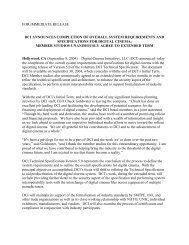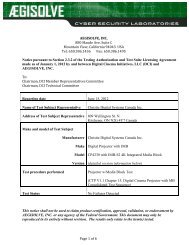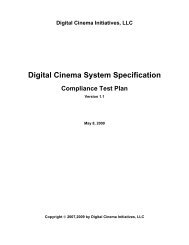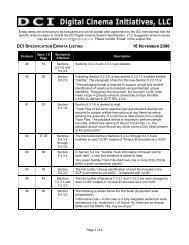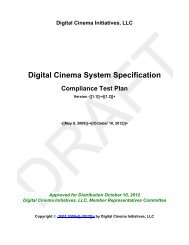DCI Specs - Digital Cinema Initiatives
DCI Specs - Digital Cinema Initiatives
DCI Specs - Digital Cinema Initiatives
You also want an ePaper? Increase the reach of your titles
YUMPU automatically turns print PDFs into web optimized ePapers that Google loves.
Functions of the Security Manager (SM), Item 9.b.9.4.5.3.3. Intra-Theater Network Housekeeping Messages9.4.5.3.3.1. TermTLSThis command, TermTLS, generates an RRP from SM to Secure ProcessingBlock (SPB) commanding termination of the Transport Layer Security (TLS)session. The RRP is executed under TLS, after which the SPB zeros all TLSsession parameters.RRP Requester RespondentSuccessful TLS session terminated TLS session terminated; resources freedUnsuccessful Error eventTable 16: RRP State: TermTLSNotes:• Transport Layer Security (TLS) layer termination process closes the underlyingTCP/IP connection.9.4.5.3.3.2. AlertThis command, Alert, is a Non-TLS UDP/IP RRP from an Secure ProcessingBlock (SPB) to an SM, or from Security Manager to Screen ManagementSystem, issued in the event of a security alarm under circumstances when (forwhatever reason) a Transport Layer Security (TLS) session and normal RRPresponses are not available to deliver the alarm.The need for this command may arise from the failure of a device, power, ornetwork. Recognizing that UDP/IP does not guarantee reliable delivery, therequester should send the command at least three times. If there is no response,a network problem should be assumed. The responder should respondidentically to each request it receives.RRP Requester RespondentSuccessful SE receives response and knowsSM received requestSM is aware of alert, (but unaware ifresponse received)Unsuccessful SE is unaware whether SM is awareof error conditionSM may or may not be aware ofrequestUnsuccessfulafter repeatsFollow error proceduresSM may or may not be aware ofrequestTable 17: RRP State: AlertNotes:• If the need for this RRP is caused by a network problem, lower level TCPcommunications may have knowledge about the error conditions. These need tobe woven into the ITM problem discovery/recovery process.• Conditions/protections for the issuance of this command must include:• Protection of the network from being jammed if the problem is with the SPB.• SPBs TLS recovery expectations, and behavior if recovery doesn’t happen.• Behavior of SPBs prior to being communicated to (e.g., power-up).<strong>DCI</strong> <strong>Digital</strong> <strong>Cinema</strong> System Specification v.1.2 Page 124




